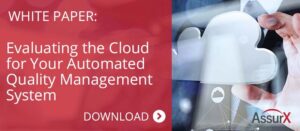March 14, 2018
If you’ve been thinking about Software as a Service (SaaS) for your QMS and trying to justify the “why”—here’s a quick case supporting cloud QMS. Though not for everyone, it makes more sense. There will always be the detractors who are not satisfied with their sensitive QMS data anywhere but in-house and these are the hard-sells. However, from pretty much any other angle, SaaS for QMS is a good fit. Here are some simple, common-sense, and compelling reasons why SaaS is a better choice.
Whose IT customer would you rather be?
Consider your firm as a customer of an established SaaS Quality Management Software provider versus your current IT department.
Often, the IT backlog is a bottleneck to getting things done. So often we hear about application owners (i.e. QMS and regulatory compliance) scrapping for the time from the IT group. I wish I had a tally of how many times I’ve heard IT departments refer to other groups in their organization as their “customers.” I’m not bashing IT groups here; just pointing out that in the modern corporate world, IT has defined itself as a “customer service” organization. Admittedly, IT does have a vested interest in keeping things running for customers. However, consider that IT also has many critical non-customer-facing application support functions and that changes how things work.
Ultimately, there’s a whole different tilt when a SaaS provider provides a service. The SaaS provider’s paycheck directly depends on providing all services reliably, regardless of whether the service is customer-facing or not. There’s more of a vested interest in rapid deployment, fixing problems faster, providing higher SLAs, and going the extra mile to make happy customers. If a SaaS provider makes a mistake, it costs directly and dearly. Plus, SaaS providers know how to install, run and maintain cloud-based software more knowledgeably than any bare metal IT group.
Professionals know SaaS for Quality Management Software
When was the last time an IT group installed software and knew more than what was in the manual? Supporting a software platform requires them to dig into troubleshooting guides as well as spend quite a bit of time on technical support lines for help.
Let’s face it—when IT installs software, they don’t know as much. How can an IT group install or manage or fix problems with the software better than those who wrote it? It stands to reason that the developer is not only the hands-down best candidate to install it, but is also the best candidate to support it. Moreover, their reputation is on the line when their platform is offered as SaaS. So much so, that, except in rare cases, most SaaS providers’ systems will be more robust than anything an internal IT group would build.
SaaS Providers have One Job
Most SaaS providers have a larger user-base than any of their on-premises customers. The providers’ systems are created to do one thing: serve their application to their customers. Alternately, IT groups are pulled in many directions and rarely have the resources to have full-time support for one application, except in the largest enterprises with the most expensive and complex of applications. Even then, resources are shared, whether it’s the disk array, bandwidth, database systems, storage, personnel, etc., SaaS providers derive their livelihood from one thing: providing nonstop service.
Conclusion
SaaS providers need to “put their money where their mouth is.” I look at it as a challenge to traditional IT groups to try and do better. I’ll be the first to throw down the gauntlet on any on-premises customer to match the robustness of the AssurX OnDemand system. In terms of security, data center certifications, data protection, application performance, compliance, dedicated resources, bandwidth, industry experience, system architecture, and dedicated staff, we have yet to see a solution as comprehensive and robust as AssurX provides our QMS customers. The question now shouldn’t be whether you should take your quality management system into the cloud, but how soon you can do it.



